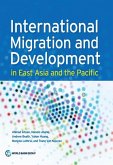This book seeks to enhance the understanding of migration in Europe and Central Asia, and to propose policy solutions tailored to the diversity of migration experiences and challenges in the region, to better leverage labor mobility for all parties.
Hinweis: Dieser Artikel kann nur an eine deutsche Lieferadresse ausgeliefert werden.
Hinweis: Dieser Artikel kann nur an eine deutsche Lieferadresse ausgeliefert werden.








